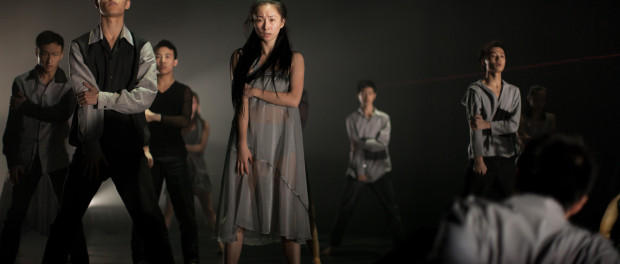The Only Certainties are Probabilities
Fault Lines opens with the 16 dancers of the Leshan Song and Dance Troupe walking about the stage, talking on their cell phones, a tick-tock rhythm in the background: citizens going about their daily business, seemingly oblivious to the ticking bomb threatening their very existence. All the while a man — is he a messenger, a scientist, an urban planner, a God? — stacks blocks on a table. Every now and then time seems to stand still for individual dancers, as they stop their urban rush and move expressively in a square of light.
Eventually text is projected onto the back wall, explaining that 403 million people live along fault lines, the places where tectonic plates shift, causing earthquakes of unpredictable magnitude.
Fault Lines is a modern dance memorial to the 70,000 dead, 18,000 missing, and 374,000 injured in the catastrophic earthquake that struck the Sichuan province in mid-west China in 2008. Many of the dancers are from the region that was affected. Drawing on their own experiences and observations they collaborated with New Zealand choreographer Sara Brodie to create this tragic, moving work that highlights the vulnerability of humans when faced with the unpredictability of a devastating natural disaster. As the projected text proclaims at one point: “The only certainties are probabilities.” And as the work makes abundantly clear, there is absolutely no way to adequately prepare for such a disaster. Hiding under a desk or standing near a door frame are not good plans, but merely platitudes spewed by bureaucrats in their futile attempts to ward off mass destruction.
I was trying not to cry for much of this performance. That being said, the breathtaking choreography and emotional devotion and technical prowess of the dancers provided many moments of stunning beauty. The combination of Asian movements adapted from kung fu and tai chi, and the choreographic language of Western modern dance, effectively highlighted the universality of suffering and loss, as well as hope and rebuilding.
Much of the work had a narrative quality: victims escaping the danger zone; a woman unable to come to terms with the loss; police tape keeping people both out and in; a boatload of victims being transported to safety. Small cues indicated profound emotions: a woman stares in horror; another woman tries in vain to dance wearing one high heel, and only finds peace when a friend kindly takes off her shoe and comforts her; a man literally carries the burden of his inconsolable wife. At one point an official gives advice on a loudspeaker and the choreography becomes socialist realism in motion as people feign strength and the power to rebuild. But the more moving portions were abstract, where the movement itself went beyond the specifics of this one event to the universal reality: that we all live with uncertainty and life gives no guarantees.
Not to be missed.
Fault Lines is at Cinquième Salle at Place des Arts from Feb. 20 to March 1 at 8pm. Tickets $30.








